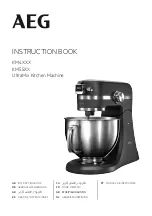
DF64 Digital Frame Manual
Version 1.0 ©1999 Euphonix, Inc.
Page 6
Component Overview
Functional Description
The DF64 Digital Frame is the Digital Signal Processing Center of System 5. Digital Audio is
routed to and from the DF64 in MADI. Control of the DF64 is provided by a Digital Pilot
Computer (one per DF64,) which in turn communicates with the System 5 Control Surface. Thus
the DF64 is under control of the System 5 system operator.
The DF64 assembly is a standard 19” rack width and 9RU high.
Applications
In its role of Digital Signal Processing Center for System 5 , the DF64 performs three
functions;
•
Signal I/O
•
Signal Routing and Synchronization
•
Signal Processing
There are 3 different types of cards in the DF64 that address each of the above functions.
The number and type of cards in the DF64 are configurable. There are one to four DF64
frames per System 5 , each of which can contain up to 14 cards. One SC253d Digital Pilot is
required for each DF64.
Signal I/O– MM641 MADI Interface Card
All audio I/O is handled by the MM641 MADI Interface Card. MADI signals input at 24 bit
fixed point resolution are converted to 32 bit floating point resolution for distribution over the
backplane to other cards (the SP-661 Signal Processor Cards use 40 bit floating point
processing internally—see below). Each MM641 card can input 224channels and output 224
channels of audio (56 channels per MADI port.) The MADI cards can also support 64 channel
MADI if an application requires this. When operating at 96kHz sample rates, each MADI port
handles 28 audio channels.
Signal Routing and Synchronization – FC631 Frame Controller Card
All patching between I/O, Channels, and Busses is done on the Time Division
Multiplexed(TDM_ bus and controlled by the FC631 Frame Controller Card. The FC631 Card
also provides a FireWire interface to the SC253d Pilot Computer. The DF64 includes a slot for a
backup FC631 card, for applications where maximum fault tolerance is required.
The DF64 typically acts as a Sample Rate Slave in System 5 synchronization, although it can
be a Master if desired. The Sync Source section on the FC631 front panel allows the user to
select between AES or Word Sync (slave mode) or Internal Sync (master mode). Once locked to
the selected sync source, the FC631 distributes a sync clock to the other cards in the DF64
frame and outputs a reference clock on its AES and Word sync output connectors. The master
Sample Rate clock signal for the DF64 and all System 5 system components comes from the
Studio Hub (SH612), which in turn can be used to synchronize other digital components in the
studio.
































